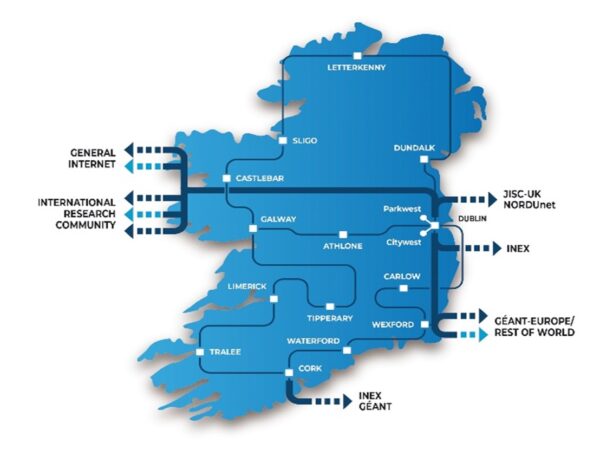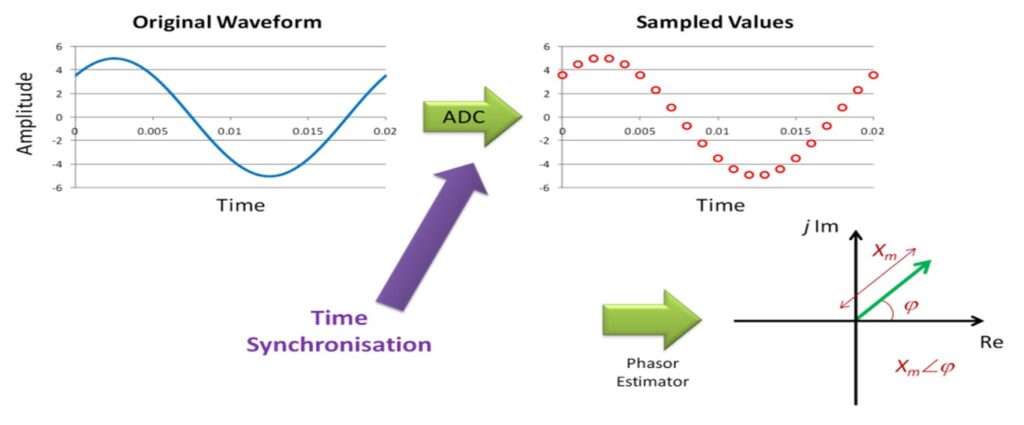Time Synchronisation Makes Monitoring the Utility Grid Possible without using ‘Space-Based’ Time
This case study presents an approach to synchronising measurement systems in electrical utility grids without using ‘space-based’ time. Synchronised measurements are important in the electrical utility as they enable novel approaches to operating the grid with high infeed’s of sustainable generation, including wind and solar, and with low carbon technologies such as electric vehicles and heat pumps. ‘Space-based’ time, such as GPS, has vulnerabilities which this case study mitigates.
The Research
Time Synchronisation makes monitoring the grid possible with Phasor Measurement Units.
Electrical power grids are monitored by instruments called Phasor Measurement Units (PMU), which use time synchronised measurements of voltage and current waveforms to produce measurements called “synchrophasors”. When synchrophasors from across a wide geographical area are studied, at the same time, they provide insight into electricity grid behaviour and facilitate research into novel approaches to support low carbon technologies and renewable generation.
The Challenges
A problem that the electrical power research faces is that utility owned PMU data often contains commercially sensitive information and is thus difficult to obtain. Even if it is obtained, it is usually subject to Non-Disclosure Agreements (NDA) and it is difficult to publish the results of analysis. A challenge that the electrical utility has is that their PMUs rely on Global Navigation Satellite System GNSS for time synchronisation. The Global Positioning System (GPS) constellation of satellites is the most common GNSS service used by PMUs. T to time, and vice versa. GNSS is known to be trivially easy to jam, and because of the space-based time, the signal is so weak, devices available online for as little as €30 would achieve this.
Whereas ‘GNSS jamming’ aims to prevent a receiver from obtaining the valid signals from GNSS satellites, GNSS ‘spoofing’ aims to deceive a receiver into following a falsified and malicious signal, not from the authentic GNSS satellite constellation. Jamming is easy to detect, there is no signal. Spoofing can be difficult to detect, as a well-constructed spoofed signal is indistinguishable from the real thing.
Original GNSS spoofing was a topic limited to military, academic and niche radio hobbyists due to the complexity and cost of the equipment involved in creating ‘spoofed’ GNSS signals. Low-cost Software Defined Radios (SDR) have changed this. Now, an SDR costing about €300 and open-source software can create fake GNSS signals.
The smartphone game ‘Pokémon Go’ relies on the player being at certain physical locations to play aspects of the game, making use of the GNSS receiver in smartphones for this purpose. In 2016, gamers used low cost SDRs to spoof GNSS signals, thereby tricking their phones into believing they were in locations they were not. This tends to show the implications that could happen if these devices became more sophisticated and were intended for larger substations.
The electricity grid still relies on GPS. Solutions are now being explored to synchronise substations without the use of GPS. Malicious GNSS jamming and spoofing is regarded by governmental security agencies as a major cyber physical attack surface affecting critical national infrastructure.
The Approach
The new technological solution that has been introduced; Precision Time Protocol (PTP) is not vulnerable to the same attack vectors as GNSS. PTP generally operates over private, wired Ethernet networks. It uses hardware time stamping, on the Physical Layer (PHY) that will synchronise the hardware clock down to picoseconds resolution.
When used on the Internet, PTP must traverse public infrastructure which may not support hardware time stamping. This will degrade the quality of time from end to end.
How does working with HEAnet address the challenges of this research?
Here are two key benefits of working with HEAnet:
For the first time, an electrical monitoring system based on PMUs will be installed across sites under the control of a National Research Education Network (NREN). This alleviates several technical and organizational issues in the creation of a dataset that may be shared with electrical power researchers. The geographically diverse locations of the NREN sites will allow researchers to investigate how electrical phenomena propagates throughout the electricity network and develop novel approaches to facilitation decarbonisation technologies.
An additional benefit is that this time synchronised sensor network presents a unique opportunity to study time transfer using PTP over a wide geographical area, thus providing an opportunity to explore innovative approaches which address the risks associated with GNSS jamming and spoofing.
HEAnet
Queens University Belfast was the first site on the HEAnet network, which can now trace its time back to National Standards Authority Ireland (NSAI).
This allows synchronisation without satellites and a monitoring solution to be built out across the island which can trace time without non-space-based technologies.
HEAnet provides a single point of contact, and the ability to put the PMU into the Point of Presence (POP) which eliminates the crossover with various information and network services and brings in connectivity. The connectivity that HEAnet can provide makes possible novel measurement approaches, such as Waveform Measurement Units (WMU) and Time Synchronised Sampled Values (TSSV).
Collaborating in this research enables HEAnet to fine tune dissemination of Time and Frequency information over the network, using the Precision Time Protocol (PTP), (which has much higher accuracy than NTP) and characterise it with respect to GNSS time.
As a result, many other research disciplines are set to benefit from the results of this work where instrumentation and measurement are key to the research: telecoms, physics, chemistry and more.

Why HEAnet POP’s ?
* Good coverage of the island
* Has an established PTP environment
* One organisation to look after ‘security matters’
* Connectivity
Conducted by:
Dr. David Laverty, Queen’s University Belfast
Roberto Sabatino, Eoin Kenny and Dónal Cunningham – HEAnet, Ireland’s Research and Education Network
The Partners
Atlantic Technological University (ATU) was formed in April 2022 from the merger of three existing technical institutes, Galway-Mayo IT, IT Sligo, and Letterkenny Institute of Technology. ATU Donegal Letterkenny has a strong record of accomplishment in computing, with post-graduate courses in Cloud and Data Centre Technology, Network Design and Cyber Security.
Queen’s University Belfast (QUB) is a member of the Russell Group, an association of 20 leading UK research-intensive Universities. Electronics, Electrical Engineering and Computer Science (EEECS) at QUB is consistently ranked one of the highest in the UK in terms of internationally excellent research output, and the undergraduate course in Electrical & Electronic Engineering was rated number 6 in the UK in the Guardian University Guide 2024.

